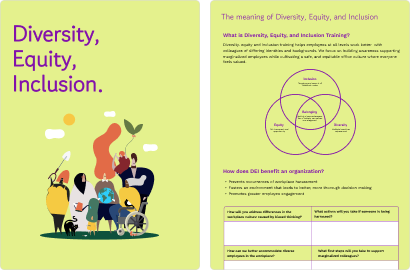3. Create visually appealing material
There’s no excuse for bland documents or pesky PDFs. Especially not if you want your content to stick. Your topic isn’t boring, so why should your materials be?
Your learning materials are a great opportunity to create an experience around your own brand, too. Using Wobo’s extensive and customizable templates, you can easily create and distribute visually appealing, branded workbooks that will elevate your learners’ interest and expectations.
Bring your training brand to life. Check out our templates today.
4. Engage through empowering your learners
As you bid adieu to your boring PDFs, consider an online workbook that empowers your learners. Instead, use a tool that engages and encourages.
With a digital workbook tool like Wobo, you can play with layouts, interactions and the type of content you make available to your learners, like radio buttons, sliders, infographics, and fillable text areas. Wobo also helps you make the information easy to revisit to continue the learning. Unlike survey tools, submissions, and convoluted email threads, Wobo allows learners to pick up where they left off, revisiting material on demand and exploring supplemental resources, keeping the learning party going long after the course has ended. Having visibility into your learner’s work also helps you provide better feedback and support to your learners.
5. Incorporate interactivity
‘Interactive’ does not mean interrogative. This is not a call to add more questions. Long form responses absolutely have their place, but that doesn’t mean they should dominate your workbook.
Mixing up response types helps reduce the amount of work a learner has to do to respond to a question. Instead of static text blocks, leverage online workbook interaction features like ranking questions, checkboxes, sliders, drop down lists and more to allow for quick interactions and pulse checks. It’s also important to mix things up with video and responses. This gives learners the opportunity to answer questions while the content is fresh in their mind. With Wobo you can break up the workbook and embed it into different parts of your course while still allowing one clean and simple download at the end of training.
6. The KISS rule applies
Keep it simple, silly.. When text gets too long it can be a blur for learners, especially if they’re expected to digest it in long training sessions. There’s a reason TED talks are limited to 18 minutes; it’s to keep it concise while delving into their topic.
Keep your writing short and sweet, and try to stick to short sections followed by quick exercises or reflection questions. Separate your information by nice to know and need to know. Include only the content that is most relevant and integral to achieving those north star learning objectives, then link out to the nice to know information with your supplemental resources.
If this is your first course and you don’t have student feedback to work from yet, try this exercise: if a given exercise will take longer than 18 minutes, break it up into smaller lessons. With Wobo, you can group exercises into modules which can be embedded throughout a course to keep it bite-sized.

